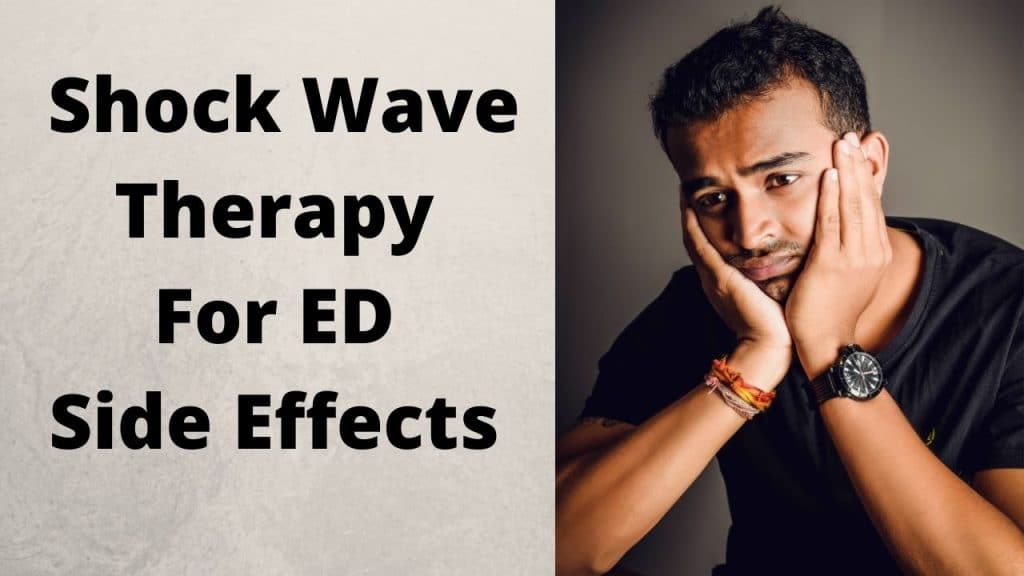
Shock Wave Therapy For ED – A Complete Guide
Shock wave therapy (SWT) for erectile dysfunction is a relatively new treatment option that shows promise.
This article will discuss the potential benefits of SWT and how it compares to other treatments for ED.
The aim of this article is to provide an overview of shock wave therapy, its efficacy in treating erectile dysfunction, as well as potential side effects and risks associated with the procedure.
It also provides insight into current research studies surrounding the use of SWT to treat ED.
By providing readers with thorough information on this innovative therapy, they can make informed decisions regarding their own health care needs.
Understanding Erectile Dysfunction
It has been widely accepted for some time now that psychological and lifestyle factors are at least partially responsible for ED, with partner involvement and risk factors also playing their part.
However, recent medical research suggests physical activity may be an even more important factor than previously thought in understanding this condition.
Physical activity can have both positive and negative effects on erectile function depending on how it is done and what stage of life it occurs in.
Low levels of aerobic exercise such as walking or jogging can be beneficial for overall health, which will indirectly improve ED symptoms in some cases.
High intensity activities like weightlifting or sprinting may cause short term fatigue, however they still offer other potential benefits to overall sexual performance.
Interestingly, there seems to be no universal consensus amongst healthcare professionals on the exact role played by physical activity when it comes to ED; while some argue it is essential for managing symptoms others believe too much exercise can worsen them further.
Ultimately though, each individual needs to find out what works best for them given their particular circumstances.
With this knowledge we can begin exploring common causes of erectile dysfunction.
Common Causes Of Erectile Dysfunction
The most common physical cause of ED is related to circulatory conditions, such as atherosclerosis or diabetes. Other risk factors for developing ED include hormonal imbalances caused by hypogonadism, pelvic trauma due to cancer treatments, spinal cord injury, multiple sclerosis, use of certain medications, neurological disorders like stroke and Parkinson’s disease, and unhealthy lifestyle habits such as smoking and excessive alcohol consumption.
In addition to these physical causes, there are also psychological effects that can lead to ED. Emotional causes may include stress at work or home, anxiety over performance issues in bed or fear of failure during intercourse. Relationship difficulties with a partner or low self-esteem can also be contributing factors.
Lifestyle changes like exercising regularly and eating healthy foods can help reduce some of these emotional triggers for ED. Making positive changes in one’s lifestyle choices can benefit overall health while helping improve erectile function when combined with other treatments prescribed by a healthcare professional.
Understanding the underlying cause(s) behind ED helps guide patients towards finding the best course of action for their individual needs.
Current Treatment Options For Ed
While lifestyle changes such as improving diet and exercise habits may help to improve sexual health, alternative treatments are available for those who wish to try something different.
Shock wave therapy has become an increasingly popular option for treating ED, with studies showing it can have positive effects on treatment effectiveness.
It should be noted that shock wave therapy does not work in every case; there are some risk factors that need to be considered before seeking this type of treatment.
These include age, obesity, underlying medical conditions, smoking status, alcohol intake, drug use, and levels of stress or anxiety.
In addition, certain medications used to treat high blood pressure or depression can also affect treatment outcomes.
For anyone considering shock wave therapy as a potential solution for erectile dysfunction it’s important to speak with their healthcare provider first.
They will be able to assess individual risk factors and provide tailored advice about whether this type of intervention might work well based on their personal circumstances.
The next step then would be to evaluate what shock wave therapy entails in terms of its benefits or drawbacks in comparison to other kinds of treatments available for ED.
What Is Shock Wave Therapy?
Shock wave therapy (SWT) is a non-invasive treatment for erectile dysfunction. It has been found to be safe and effective, with long term results in some patients.
SWT involves delivering acoustic shock waves directly to the penis which can encourage new blood vessel growth and help improve erections. The success rates of SWT vary between individuals but it is estimated that around two thirds of men who have undergone this procedure will experience improved sexual performance.
Potential side effects are typically mild and may include temporary bruising or discomfort. As a result, many consider shock wave therapy as an attractive alternative to more traditional treatments such as medication or surgery.
With minimal risks associated with this kind of treatment and potential significant benefits, shock wave therapy could provide a viable solution for those suffering from erectile dysfunction.
How Does Shock Wave Therapy Work?
Shock wave therapy uses low-intensity sound waves directed at penile tissue which stimulates blood flow, increases nerve growth and enhances sensitivity. These effects can help improve the overall quality of erections in men with ED.
However, there are also some potential long term risks associated with shock wave therapy including bruising or swelling around the treated area as well as altered sensation in the penis due to damage done to nerves during treatment. It is therefore important to discuss any concerns regarding these risks with a medical professional before undergoing this type of procedure.
In addition to discussing potential risks and side effects associated with shock wave therapy, patients should also consider making lifestyle changes such as quitting smoking or reducing alcohol intake if they wish to achieve optimal results from their treatments. Clinical trials conducted on shock wave therapy suggest that diet and exercise may play an integral role in its success rate; thus emphasizing the importance of following medical advice after treatment sessions have been completed.
Benefits Of Shock Wave Therapy For Erectile Dysfunction
Shock wave therapy for ED has been demonstrated to be a safe and effective treatment option. There are numerous benefits associated with this type of therapy, including improved psychological effects, lifestyle changes, diet modifications, and alternative therapies for age-related issues.
The physical benefits provided by shock wave therapy include increased blood flow that may improve symptoms in men suffering from ED. Additionally, studies have shown that there may be an improvement in sexual performance as well as satisfaction among patients who underwent shockwave treatments. This suggests that shock wave treatment could potentially provide long term improvements in quality of life for those affected by ED.
Furthermore, shock wave therapy offers potential mental health benefits due to its ability to reduce stress levels and anxiety associated with ED. Improved mental health can lead to improved overall wellbeing, both physically and psychologically. Patients also reported feeling more empowered after receiving this form of treatment as they felt they had taken control over their condition rather than letting it take control of them.
These positive results indicate that shock wave therapy provides significant advantages when used correctly to treat ED. With these advantages in mind, understanding who can benefit from this form of treatment becomes all the more important.
Who Can Benefit From Shock Wave Therapy?
Who can benefit from shock wave therapy? Understanding the risk factors associated with erectile dysfunction, as well as the psychological and relationship impacts it can have, is important in determining eligibility for this form of treatment.
Certain lifestyle changes, such as exercising regularly and maintaining an overall healthier diet are recommended by medical professionals when treating erectile dysfunction. Shock wave therapy may be beneficial depending on the severity of the condition and whether any underlying physical conditions exist that prevent its successful use.
For example, men who suffer from diabetes or heart conditions may need to seek alternative treatments due to their greater likelihood of experiencing adverse reactions. Moreover, certain medications used to treat high blood pressure or depression might affect a man’s ability to respond positively to shock wave therapy.
Therefore, it is essential for patients to consult with their doctor prior to undergoing such a procedure so they can receive personalized advice about what approach is most likely to produce favorable results. It is also critical that individuals understand how different forms of ED treatment could potentially impact their intimate relationships before making decisions about whether or not they should pursue this form of therapy.
With these considerations in mind, those interested in exploring shock wave therapy for ED should discuss all available options with their healthcare provider before getting started.
Moving forward then into understanding what will happen during a shockwave session – it’s important to note what kind of equipment will be used and why each component plays an integral role in providing comfort while administering effective care.
What To Expect During A Shock Wave Therapy Session
A shock wave therapy session for erectile dysfunction treatment is a life-changing experience. It’s like stepping into the future as you prepare to take on a new approach with your health and wellness.
Preparing for a shock wave therapy session requires some assessment and research beforehand.
Patients should be aware that expectations may differ from reality when it comes to outcomes and long-term effects. The risks and benefits associated with the procedure must also be explored before starting any course of treatment.
The results of shock wave therapy can vary depending on each person’s situation; however, general improvements have been reported after receiving multiple sessions. Ultimately, understanding how the body will respond during this kind of procedure helps patients make informed decisions about their care while still getting the most out of their treatments.
As such, researching potential therapies and talking to medical professionals are essential steps towards successful therapy outcomes.
Is Shock Wave Therapy Safe?
As with any medical intervention, there are potential risks that should be taken into account before deciding whether this type of treatment is right for you.
The goal of shock wave therapy is improvement in quality of life, so it’s essential to weigh both the positive and negative outcomes when considering if this form of treatment is appropriate for your condition. The most common side effect experienced after shock wave therapy sessions is mild soreness which generally resolves quickly without further intervention.
While serious adverse events are rare, it’s important to discuss any concerns about safety with your doctor before undergoing this type of treatment. Knowing all available information will help ensure you make an educated decision on whether pursuing shock wave therapy is best for your individual circumstances. With this knowledge, patients can have greater confidence in their choice – whatever it may be – knowing they’ve weighed all options carefully.
Side Effects Of Shock Wave Therapy
The most common short-term side effect reported from patients undergoing shock wave therapy for erectile dysfunction is mild discomfort at the site of the treatment. Other possible risks include swelling or bruising in the area where the pulses were delivered as well as numbness or tingling sensations near treated areas. While these symptoms typically resolve within one week following treatment, if they persist longer than expected then a follow up visit with your doctor is recommended.
Patient experience also plays an important role in understanding how shock wave therapy can affect individuals differently. In some cases, people report improved sexual performance after undergoing this therapy while others do not see any change at all. It is essential to discuss expectations and outcomes with your doctor prior to beginning this type of treatment so you can make an informed decision about whether it’s right for you.
How Long Does Shock Wave Therapy Take To Work?
Having discussed the side effects of shock wave therapy, it’s now essential to consider how long this form of treatment can take to produce effective results.
Generally speaking, most patients require multiple sessions over a period of weeks or months before they begin to experience the positive outcomes associated with shockwave therapy for ED. The number of required sessions is largely dependent on each individual patient’s unique case and their response to the treatment modality.
It is important to look at both short-term and long-term effects when considering any type of therapeutic intervention such as shockwave therapy. In terms of its efficacy in treating erectile dysfunction, studies suggest that shockwave therapy offers numerous benefits including improved blood flow, increased nerve regeneration and enhanced tissue remodeling which all lead to better sexual performance for patients. Furthermore, many men have reported an improvement in their overall quality of life following successful treatments with shockwave therapy.
How Many Sessions Of Shock Wave Therapy Are Needed?
Shock wave therapy for erectile dysfunction has been found to be an effective treatment option, yet the question of how many sessions are necessary remains.
Patients may find that lifestyle modifications such as dieting or exercising regularly can improve their overall health and reduce the chances of needing multiple treatments.
Post treatment care is important in order to maintain optimal results and minimize any potential side effects.
From there, it becomes possible to combine shock wave therapy with other forms of treatment depending on the severity of the condition being treated, ultimately giving patients more options for achieving successful outcomes.
Moving forward, further studies need to be conducted in order to better understand the long-term effects of this form of treatment in men suffering from ED.
Combining Shock Wave Therapy With Other Treatments For Erectile Dysfunction
In some cases, combining shock wave therapy with other treatments such as medications, nutrition and lifestyle changes may further enhance its effectiveness. One example of this was seen in a study published in 2019 which followed 74 patients who had received both shock wave treatment and nutritional counseling for their ED.
The researchers found that after three months, there was an improvement in 68% of the participants’ symptoms. This suggests that when combined with other forms of therapy, shock wave treatment can be even more effective than when used alone.
Cost Of Shock Wave Therapy For Ed
The cost of shock wave therapy for erectile dysfunction is a significant consideration when deciding whether to pursue treatment. The financial impact can be substantial, as the procedure typically requires multiple sessions, depending on the severity and duration of ED symptoms.
Fortunately, some insurance plans offer coverage for shock wave therapy, although it may require authorization from a primary care physician or urologist before it is approved.
Conclusion And Future Directions For Shock Wave Therapy
The cost of shock wave therapy for erectile dysfunction can be a significant financial burden, but there are several factors to consider in terms of its long-term efficacy.
Research has shown that shock wave therapy is effective and safe for treating ED, with patient satisfaction reaching levels comparable to those achieved with other treatments. It has also been found to have an acceptable safety profile and minimal potential risks when used correctly.
In addition to being relatively low risk, shock wave therapy is also cost effective compared to other treatments such as penile implants or drugs like Viagra.
Furthermore, the psychological effects that can result from successfully treating ED should not be overlooked; improved self-esteem and confidence often accompany successful treatment outcomes.
Overall, it appears that shock wave therapy offers hope for men struggling with the physical and emotional symptoms of ED. Its effectiveness combined with its relative affordability make it an attractive option for many patients seeking relief from their condition without breaking the bank.
Further research into this promising treatment may yield additional insights into its potential benefits and risks over time.
Conclusion
Shock wave therapy is an innovative, non-invasive treatment option for erectile dysfunction that has shown promising results in clinical studies. Its effectiveness lies in its ability to target the underlying causes of ED and help restore normal functioning of blood vessels and nerves. The procedure involves a series of short sessions with minimal side effects.
Shock wave therapy can be used alone or combined with other treatments depending on individual needs. While there are some costs associated with shock wave therapy, it offers a viable alternative to traditional treatments, providing hope for those suffering from this condition.
For many men, shock wave therapy provides renewed hope and improved quality of life after being diagnosed with ED. One patient shared his story; “After years of struggling with ED I felt like my options were limited until I heard about shock wave therapy. After just two sessions I was able to regain my confidence in the bedroom and finally feel like myself again” – illustrating how effective shock wave therapy can be at restoring sexual health and improving overall wellbeing.
Disclaimer
The information provided in this article should not be used as a substitute for medical advice, diagnosis, or treatment. Always seek the guidance of a qualified healthcare provider before making any changes related to treatment or lifestyle. If you have any questions or concerns regarding your condition, the appropriate medical professional should always be consulted. The content posted here is not intended to diagnose health problems or take the place of professional medical care.
References:
- Healthline. (2021). Shockwave therapy for ED: Does it work? Retrieved from https://www.healthline.com/health/shockwave-therapy-for-ed
- European Association of Urology. (2021). Shockwave therapy for ED. Retrieved from https://uroweb.org/guideline/male-sexual-dysfunction/
- Mayo Clinic. (2021). Erectile dysfunction: Treatments and drugs. https://www.mayoclinic.org/diseases-conditions/erectile-dysfunction/diagnosis-treatment/drc-20355782

